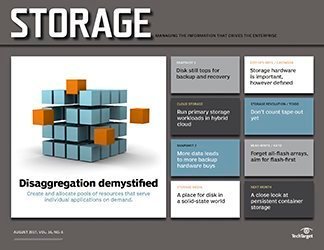PRO+ Premium Content/Storage
Access your Pro+ Content below.
Hybrid cloud technology gets the most out of primary storage workloads

This article is part of the Storage issue of August 2017, Vol. 16, No. 6
The promise of smooth-functioning, cost-effective hybrid cloud storage has long been of interest to IT professionals. "Hybrid" has been in the cloud lexicon from the beginning, when the National Institute of Standards and Technology issued its original definitions of various cloud deployment models. Hybrid cloud storage broadens the workload deployment choice to more than one cloud and enables compelling use cases, such as off-site backup, disaster recovery and cloud bursting. Done right, an enterprise hybrid cloud improves IT agility while reducing cost. Up until recently, however, major challenges kept companies from embracing the promise of hybrid clouds, particularly for primary storage. These obstacles fall into four categories: Lack of standard interfaces and tools. Workload portability, a prerequisite for hybrid clouds, has been hampered by a lack of standard APIs and a lack of runtime environments that let companies easily move their apps and data between on-premises and public clouds. While containers have facilitated ...
Features in this issue
-
Disaggregating network, compute and storage allocation demystified
Explore the ways disaggregation concepts and principles are being applied to create and allocate pools of compute and storage resources to serve applications on demand.
-
Hybrid cloud technology gets the most out of primary storage workloads
Learn what to look for in a hybrid cloud platform so you can take advantage of the scalability, agility and cost benefits it has to offer primary storage.
Columns in this issue
-
Software-defined storage products don't negate hardware's importance
Software-defined storage, positioned as the cure-all for vendor lock-in, suggests that hardware may not be as important to IT infrastructure as it once was.
-
Forget all-flash arrays, aim for flash-optimized storage first
Look for simple, cost-effective products that are optimized for flash and meet your needs rather than focusing on the all-flash array storage that vendors are pushing.
